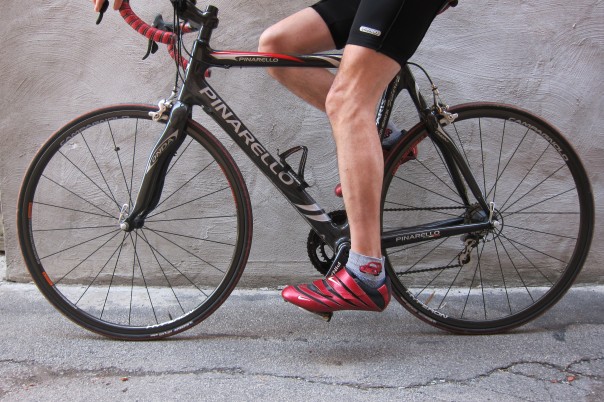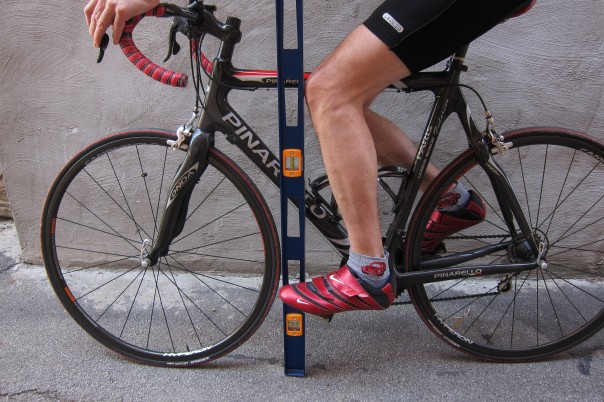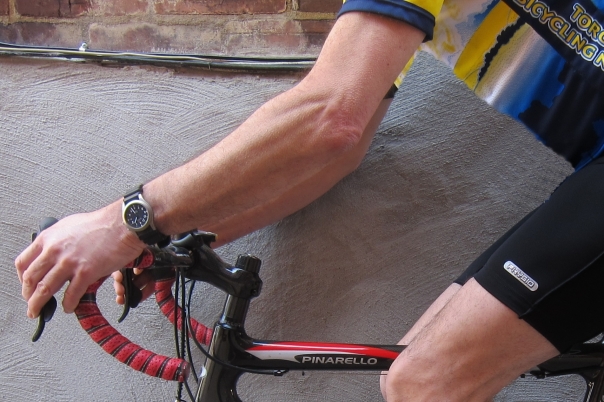
Everything you need to keep you–and your bike–happy: a pump, chain cleaner, degreaser fluid, chain lube, helmet, u-lock.
By The Maven | I was in Portugal 18 months ago for a cycle trip from Lisbon to the Algarve. We rented bikes from Portugal Bikes, a locally owned small cycle touring company–great people and good prices if you ever go.
The shop owner asked our nationality before prepping us on basic bike maintenance. He was relieved to hear we were Canadian, mechanically competent people. The Dutch, he said, were completely incapable of doing any maintenance work on their bikes. Since a cycle shop can be found on every corner in Holland, they can’t even fix a flat tire he told us.
So as Canadians we have an international standard to maintain, to wit, some advice.
1. Cleaning: Clean your bike. If it’s been in use in the salt and slush of winter, hose it down. If it sat outside or in the basement for the winter it still needs to be cleaned and lubricated.
Cleaning the chain is the most important for a smooth and happy ride. You can just hose it down, let it dry and then oil it.

Take the top off the bike chain cleaner, add de-greasing fluid, fit your chain in the cogs, snap on the top, and rotate your pedals backward about 100 revolutions.
But best to clean it properly. MEC sells a nice chain cleaner for only $5.50 and a bottle of citrus-based biodegradable degreaser for the same amount. Why degreaser? Because the oil on the chain picks up dirt and abrasive particles and this grit acts like sandpaper to wear down and destroy your chain, cogs, and chain rings. Shifting becomes rougher and requires more force, you skip gears, ugliness–in the form of a repair bill to replace your drive chain–soon ensues.
With a chain cleaner you simple fill up the chamber with a degreaser, click it on to the chain and run the chain through it for a couple of minutes. The chamber will become black and disgusting while the chain will become shiny and silver again.
I also pour some degreaser directly on the derailleur and cogs and let it sit a while. You can then wipe all these parts down with a rag or rinse them with water. After everything has thoroughly dried (I like to do cleaning on a sunny day and let my bike sit in the sun for an hour to dry) you need to re-grease the chain. Do NOT use 3-in-1 or household oil. By oil specifically for a bike.
Or make a homebrew like I do. I mix one part light grade synthetic motor oil to three parts mineral spirits (pain thinner). I apply it liberally to my chain and all moving parts of my bike. The idea is that the mineral oil thins the oil and helps it penetrate and carry into metal parts. The mineral spirits then evaporates leaving behind the lubricating oil. About $10 worth of ingredients has lasted several years for me, and I maintain four bikes of my own and three of my son’s. I oil my road bike chain after every one or two rides. I will wipe down the chain and re-lube. I do a full clean ever few weeks.
2. Tire pressure: Information about optimum inflation pressure is printed or embossed on the sidewall of your tire.
Tire pressure is crucial. The maximum inflation is on the tire side wall. If you are heavier go toward the higher end. Up to a point a higher pressure will aid efficiency but your ride may be a bit bumpier. Too little air can cause ‘pinch’ flats by pinching the sidewall of the tire between the road and the rim. And the bike won’t ride very nicely on half flat tires.
Tires lose air daily. The rubber tubes are not entirely air proof. There is some leakage. The higher the tire pressure (eg: road bikes) the faster the leakage. Pump your tires twice weekly at least. A good quality pump is worth the extra few bucks as it makes pumping so much easier.
I even use my bicycle pump to pump up my car tires (ok, I’m a little obsessive about these things).
3. Inspect your bike
It’s a good idea to just walk around your bike and do an inspection now and again.
Check the brakes are not rubbing and that they stop a spinning wheel promptly. Check that the crank and headset have no play in them. If you are riding a single speed–particularly a fixie–the crank is your bread and butter. Keep it tight!
You may not realize it but metal not only fatigues and breaks but also stretches. For instance, not only do your brake and gear cables needs tightening but your chain stretches. Not checking and replacing the chain when it needs it can wear the rear cogs and front chain rings, and then they too will need premature replacement…something that is much more expensive than a new chain.
If you aren’t confident enough or knowledgeable enough to do this stuff on your own, spend a few bucks at your local bike shop. Rob Bateman of Bateman’s Bicycle Company at 913 Bathurst just north or Barton is a great local guy and cycle enthusiast. He and his guys will look after your bike for a reasonable price.
A well tuned bike is a pleasure to ride.
___________________________________________________________________________________________________________
The Maven is a Serotta-certified bicycle fitter who lives, works, and cycles in the Annex. Visit his blog at www.TOmaven.wordpress.com.
For other cycling articles by the The Maven on the West Annex News, visit the Bike Maven archive.





















